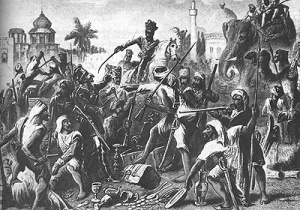Bhai Ram Singh: Difference between revisions
No edit summary |
Allenwalla (talk | contribs) m (had 1963 / expanded a bit) |
||
| Line 1: | Line 1: | ||
'''Sikhism does not in anyway support the concept of human Gurus after [[Guru Gobind Singh]].''' | ::::'''Sikhism does not in anyway support the concept of Living human Gurus after [[Guru Gobind Singh]].''' | ||
Please DO NOT ADD CONTROVERSIAL INFORMATION | :::::::Please '''DO NOT ADD CONTROVERSIAL INFORMATION''' to this Page | ||
<hr> | |||
<hr> | |||
[[Image:SepoyMutiny.jpg|300px|right|1857, Revolt was in the Air]] | |||
'''Bhai Ram Singh''' was born in 1826 at village Bhaini in the District of Ludhiana. His father, Jassa Singh, worked as a carpenter in his village. When Bhai Ram Singh grew up, he joined the Khalsa Army and served for several years in the Risala (Cavalry) of Kanwar Nau Nihal Singh, Grandson of [[Maharaja Ranjit Singh]]. During his service in the Khalsa he fell under the spell of a Sikh saint and under his influence left the army. | |||
In 1857, the year of the [[Purbia Revolt]] when both individual Hindu and Muslim units revolted against the British hoping to re-establish their previous rulers and small kingdoms, Bhai Ram Singh had a small revolt of his own in mind, not against the British but rather against his own Sikh Religion, and founded what he called the Sant Khalsa, which became the nucleus of his [[Namdhari]] or Kuka movement. | |||
In 1863, Bhai Ram Singh issued a comprehensive code of discipline for his followers. The code went a long way in consolidating the ranks of the Namdhari also called the Kuka movement. There were many differences between his Sant Khalsa and the [[Khalsa]] to which he had once belonged. | |||
[[Category: Bhai]] | [[Category: Bhai]] | ||
Revision as of 20:39, 31 December 2007
- Sikhism does not in anyway support the concept of Living human Gurus after Guru Gobind Singh.
- Please DO NOT ADD CONTROVERSIAL INFORMATION to this Page
- Sikhism does not in anyway support the concept of Living human Gurus after Guru Gobind Singh.
Bhai Ram Singh was born in 1826 at village Bhaini in the District of Ludhiana. His father, Jassa Singh, worked as a carpenter in his village. When Bhai Ram Singh grew up, he joined the Khalsa Army and served for several years in the Risala (Cavalry) of Kanwar Nau Nihal Singh, Grandson of Maharaja Ranjit Singh. During his service in the Khalsa he fell under the spell of a Sikh saint and under his influence left the army.
In 1857, the year of the Purbia Revolt when both individual Hindu and Muslim units revolted against the British hoping to re-establish their previous rulers and small kingdoms, Bhai Ram Singh had a small revolt of his own in mind, not against the British but rather against his own Sikh Religion, and founded what he called the Sant Khalsa, which became the nucleus of his Namdhari or Kuka movement.
In 1863, Bhai Ram Singh issued a comprehensive code of discipline for his followers. The code went a long way in consolidating the ranks of the Namdhari also called the Kuka movement. There were many differences between his Sant Khalsa and the Khalsa to which he had once belonged.

